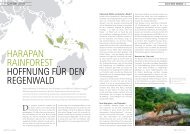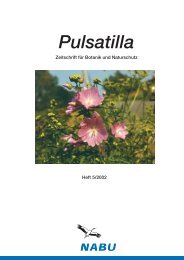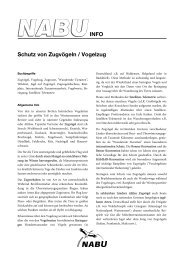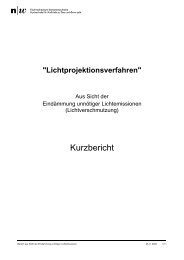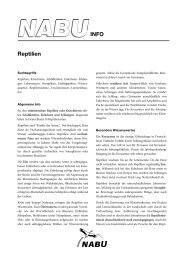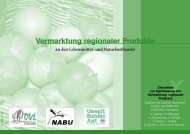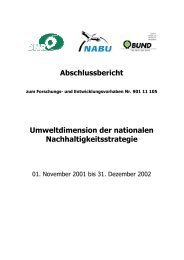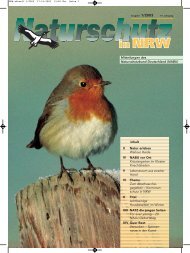Studie "The GMO-emperor has no clothes" (engl.) - Nabu
Studie "The GMO-emperor has no clothes" (engl.) - Nabu
Studie "The GMO-emperor has no clothes" (engl.) - Nabu
You also want an ePaper? Increase the reach of your titles
YUMPU automatically turns print PDFs into web optimized ePapers that Google loves.
with GM. 31 In Brazil, GM cotton represented a<br />
small portion of total plantings in 2009/2010. 32<br />
Generally, the governments of the region,<br />
especially in Brazil, Argentina and Uruguay,<br />
have facilitated the introduction of GM crops<br />
by adapting their regulatory frameworks and<br />
basing their risks assessments on the information<br />
provided by the biotech<strong>no</strong>logy industry.<br />
Authorization for GM soy was first granted by<br />
governments in Argentina and Uruguay in 1996.<br />
Monsanto went forward with GM plantings in<br />
2004/2005 in Brazil despite <strong>no</strong>t receiving the<br />
proper authority to do so by the government.<br />
Instead of controlling and punishing those who<br />
have illegally introduced these crops into the<br />
countries, government officials have adapted their<br />
regulations to allow GM crops and often argue<br />
that because the crops already exist, they should<br />
be authorized. Today in Brazil, the authorization<br />
for approval of GM crops is under the purview of<br />
a 2005 Biosafety Law that <strong>has</strong> left decision making<br />
on <strong>GMO</strong>s to a technical committee, CTNBio.<br />
This committee is comprised of a handful of<br />
scientists, many with connections to biotech<strong>no</strong>logy<br />
companies. 33 All applications for commercial<br />
release if GM crops in Brazil have been approved<br />
since 2005 as a result of the change to the approval<br />
process.<br />
Between 1996 and 2007, the use of agrochemicals<br />
increased from 30 to 270 million liters. Herbicide<br />
imports increased 330 percent with the<br />
introduction of GM soy. As compared to use on<br />
traditional fields, 9.1 million kilograms more of<br />
herbicides were used in genetically modified soy<br />
plantations in 2001 alone.<br />
Super weeds are emerging as a result of massive<br />
application of glyphosate 34 . In Brazil, researchers<br />
have reported that some weeds have developed<br />
tolerance to glyphosate in nine species, four of<br />
which are weeds that can cause serious problems<br />
to crops 35,36 . Over 30 million liters of glyphosate<br />
was sold in 1991, 8.2 million in 1995, to over 30<br />
million in 1997. In 2008 between 160 and 180<br />
million liters of glyphosate were used.<br />
In Argentina, deforestation increased almost by<br />
42 percent as a result of the expansion of the<br />
agricultural frontier, mainly the expansion of soy<br />
mo<strong>no</strong>culture plantations. Complete habitats have<br />
been lost. Some calculations assess that in the<br />
past 30 years, Argentina <strong>has</strong> lost 70 percent of its<br />
native forests.<br />
<strong>The</strong> high use of glyphosate <strong>has</strong> had grave<br />
implications for soil, air, water, and public health.<br />
In Argentina, health networks of Doctors in<br />
Sprayed Towns of Argentina have documented<br />
links between the increase of agrochemical use<br />
and increasing rates of cancer, miscarriages, fetal<br />
malformations and respiratory conditions, among<br />
other impacts. 37<br />
Voices from Europe<br />
European Union<br />
Almost <strong>no</strong> GM crops exist in the European<br />
Union (EU). Spain is the country with the<br />
highest amount of GM crops—70,000 hectares<br />
(out of 182 million hectares of agricultural<br />
lands) are planted with mainly GM corn. Other<br />
European countries that have planted GM crops<br />
include: Czech Republic—3,000 hectares and<br />
Portugal—500 hectares. Germany, the UK, and a<br />
few other countries have very small amounts of<br />
land growing GM crops.<br />
Only two <strong>GMO</strong> events are presently approved<br />
for cultivation within the EU: Monsanto’s<br />
“Mon-810” insecticidal maize, and a potato<br />
“Amflora” of BASF, Germany, which is supposed<br />
to ease starch processing for industrial use<br />
and presently accounts for 2 ha in Germany.<br />
“Mon 810”, though officially approved by the<br />
Union, <strong>has</strong> since been banned for cultivation by<br />
Germany, Austria, France, Greece, Luxembourg,<br />
31<br />
Information available at: http://www.argenbio.org/adc/uploads/imagenes_doc/planta_stransgenicas/TablaArgentinaOGM.<br />
ppt.<br />
32<br />
Information available at: http://www.cib.org.br/estatisticas.php<br />
33<br />
A ciência segundo a CTNBio. Revist Sem Terra Nº 53, November 2009, available at: http://boletimtransgenicos.mkt9.<br />
com/registra_clique.php?id=H|65072|15226|8993&url=http://www.mst.org.br/sites/default/files/A_ciencia_segundo_a_<br />
CTNBio_REVISTASEMTERRA.pdf.<br />
34<br />
Argentina: las consecuencias inevitables de un modelo ge<strong>no</strong>cida y ecocida. Biodiversidad sustento y culturas Magazine,<br />
August 2009, available at: http://www.biodiversidadla.org/content/view/full/50874<br />
35<br />
Review of potential environmental impacts of transgenic glyphosate-resistant soybean in Brazil. Cerdeira et al, 2007,<br />
available at: http://www.informaworld.com/smpp/content~content=a779480992.<br />
36<br />
Buva “transgênica” resiste ao glifosato. Gazeta do Povo, December 1st, 2009. http://portal.rpc.com.br/jm/online/<br />
conteudo.phtml?tl%3D1%26id%3D950000%26tit%3DBuva-transgenica-resiste-ao-glifosato.<br />
37<br />
http://www.reduas.fcm.unc.edu.ar/declaracion-del-2%C2%BA-encuentro-de-medicos-de-pueblos-fumigados/.<br />
36



